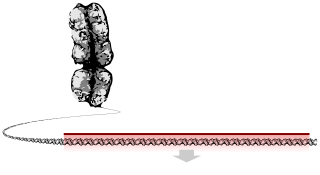
Back Geen (genetika) Afrikaans Gen ALS جين Arabic چين ARZ Xen AST Gen Azerbaijani Ген Bashkir Ген Byelorussian Ген BE-X-OLD Ген Bulgarian
| Part of a series on |
| Genetics |
|---|
 |
In biology, the word gene has two meanings. The Mendelian gene is a basic unit of heredity. The molecular gene is a sequence of nucleotides in DNA that is transcribed to produce a functional RNA. There are two types of molecular genes: protein-coding genes and non-coding genes.[1][2][3] During gene expression (the synthesis of RNA or protein from a gene), DNA is first copied into RNA. RNA can be directly functional or be the intermediate template for the synthesis of a protein.
The transmission of genes to an organism's offspring, is the basis of the inheritance of phenotypic traits from one generation to the next. These genes make up different DNA sequences, together called a genotype, that is specific to every given individual, within the gene pool of the population of a given species. The genotype, along with environmental and developmental factors, ultimately determines the phenotype of the individual.
Most biological traits occur under the combined influence of polygenes (a set of different genes) and gene–environment interactions. Some genetic traits are instantly visible, such as eye color or the number of limbs, others are not, such as blood type, the risk for specific diseases, or the thousands of basic biochemical processes that constitute life. A gene can acquire mutations in its sequence, leading to different variants, known as alleles, in the population. These alleles encode slightly different versions of a gene, which may cause different phenotypical traits.[4] Genes evolve due to natural selection or survival of the fittest and genetic drift of the alleles.
- ^ Cite error: The named reference
mendgene2was invoked but never defined (see the help page). - ^ "What is a gene?: MedlinePlus Genetics". MedlinePlus. 17 September 2020. Archived from the original on 16 May 2020. Retrieved 4 January 2021.
- ^ Hirsch ED (2002). The new dictionary of cultural literacy. Boston: Houghton Mifflin. ISBN 0-618-22647-8. OCLC 50166721.
- ^ Elston RC, Satagopan JM, Sun S (2012). "Genetic terminology". Statistical Human Genetics. Methods in Molecular Biology. Vol. 850. Humana Press. pp. 1–9. doi:10.1007/978-1-61779-555-8_1. ISBN 978-1-61779-554-1. PMC 4450815. PMID 22307690.
